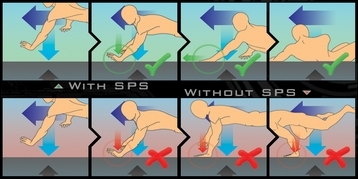Hands and wrists
Overview
Broken wrists often result when riders fall forward and catch themselves with their hands– a common injury for riders without safety gear. Experienced riders often consider wrist guards to be a requirement for riding. Skate-style wrist guards provide good protection against these injuries.
After wrist injuries, the most common hand injury is scratching up fingers due to abrasion with asphalt. This becomes more important at higher speeds. To combine wrist and hand protection, one option is to wear wrist guards over a protective glove.1 There are also convenient wrist guard/glove combinations available.
Wrist protection
Most wrist guards use the following three components (ordered by importance for a typical EUC forward fall):

- Sliders. Sliders help your wrists slide on the ground, reducing the initial impact on your wrists and making hyperextending less likely, especially when falling on asphalt.
- Bottom splint. The bottom splint absorbs and redirects the impact, and to some extent can keep your wrist from hyperextending. The bottom splint and slider are often combined into a single piece.
- Top splint. The top splint keeps your wrist from hyperextending (this one is more important for backward falls)
Generally, skate-style wrist guards tend to work the best for EUCs. Other types of wrist guards, for snowboarding for example, may not include sliders or bottom splints.
In Europe wrist guards are CE certified under the EN 14120 roller sports standard. The standard includes 2 levels– level 1 for “normal roller sports” and level 2 for “acrobatic roller sports”. I don’t know of any wrist guard certified as level 2.
The Demon Flexmeter is supposed to be the safest wrist guard, at least according to its designers. However I don’t know of any systematic evidence demonstrating this. In theory wrist guards could be compared using their CE certification test results, but Demon seems to have lost the Flexmeter test results.
Combined glove and wrist guard options
Gloves with wrist guards aren’t too common, but there are a few. The most protective options are skate-style gloves or purpose-made gloves for EUC and Onewheel, though some motorcycle gloves also have decent wrist protection.
Skate, e-skate, and EUC/Onewheel gloves
Hillbilly and GyroRiderz gloves both combine full skate-style wrist guards with abrasion resistant gloves. This is an ideal combination for a lot of EUC riding, so these gloves are widely used. f(x)nction’s Sender wrist guards are similar, but without the top splint.
E-skate gloves require more flexibility (to hold an e-skate remote), but often still include wrist protection. flatland3d’s Carbon E-Skate Gloves have both Knox palm sliders and a flexible top splint. The palm sliders allow hands to move more but don’t protect as much as a skate-style wrist guard.
Motorcycle gloves
Some motorcycle gloves have palm sliders meant to prevent wrist injuries. Knox in particular is known for making good palm sliders. Motorcycle gloves don’t include either a top or bottom splint because motorcyclists need to flex their wrists.
Despite lower levels of wrist protection, a possible benefit of motorcycle gloves is that you can get higher levels of abrasion resistance. EN 13594 is the relevant CE standard. Gloves can be certified as level 1 or level 2. For EUCs level 1 is probably adequate, though I haven’t yet found all the details of the standard.
Many motorcycle gloves also offer knuckle or finger impact protection, but this is a lower priority for EUC.
-
I’ve tried wearing wrist guards underneath gloves instead, but it doesn’t work well. If the gloves don’t have built-in palm sliders, then they won’t slide well. If the gloves do have built-in sliders, then the wrist guard underneath pushes the sliders out of place so they may not work correctly. ↩